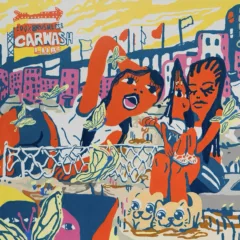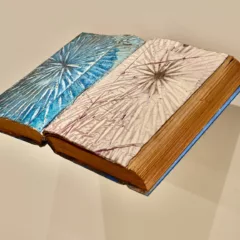The Chris Ofili mid career survey at the Tate Britain reveals a sexually charged and scatalogical body of work reminiscent of Gilbert and George’s The Naked Shit Pictures. This survey contains overlooked sensations and under-exploited materials. The energies driving the early works have been tamed and the latest works are in an amorphous state of disarray. This could be one of the futures most exciting shows if Offili finds the new path he is looking for.
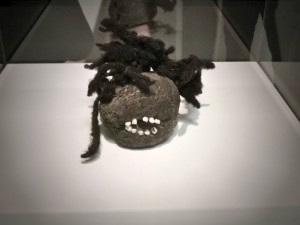
The survey is organized chronologically from beginning to current. Dung, with its fibrous texture, is there from the beginning. (I recall Ofili’s self portrait from art school of a boy sitting on a toilet with his pants at his ankles). Dung ties the show together without ever being developed as a sculpting or painting material in its own right. In ball form it serves as painting pedestal, a solar, earthly or meteoric reference in his orbital compositions and a cute puppet-like entity that follows his subjects wherever they go. But the sculptural potential as enunciated by ” Shit Head” is abandoned. Rather, it establishes a formal identity throughout all of the works and creates ambiguities between the human forms and the piles of dung.
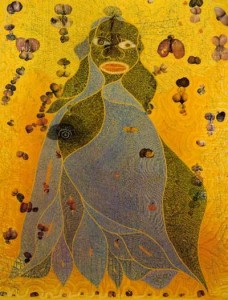
Up until 1999 or so the paintings are exuberant, sexy, rythmical and musical. They are like a fantastic series of album covers employing glitter, resin and magazine cut outs. Offili’s mojo is on fire. The notorious Virgin painting is an eye opener. Unbeknownst to this writer the painting abounds with balls of female genitalia. It was the controversial dung that was the red herring. Offili’s 90’s feel like 1970’s kaleidoscopes on steroids.
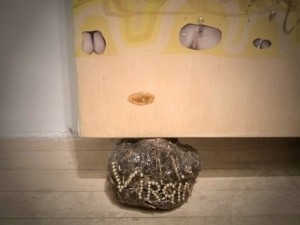
Next we come to the “Upper Room”, a plywood chapel designed by David Adjaye to house a series of 13 chalice bearing (Holy Grail?) Macaque monkies, a primate known for its strict hierarchical society as well as posessing keen compassion. I am told that the monkey also symbolises sexuality in Christian iconography. There are six in profile on each side of the chapel and are identical save for their colors which seem to be under some kind of aural sway . They lead to the head monkey which is facing us and painted in gold. You may need a monkey on your back to fully appreciate this work which seems more like Ofili’s private chapel. It is at this point that we start to wish for unholy alliances to crown all of these provocative proximities but Offili won’t let them consumate. The Virgin feeding the monkey or even loving it as in the film ” Max Mon Amour’ where Charlotte Rampling falls in love with a gorilla, would have been exciting.
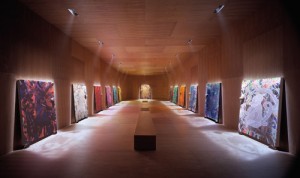
The next room is contains larger and darker paintings whose subjects are set in the jungle. A setting resulting from Ofili’s relocation from London to Trinidad. Has Ofili found lasting love? Red abounds and couples enlace. There are more beads than ever and the light is dimming. We then pass back into a room full of earlier exuberant watercolors of hairdos and odalisques. The heads of hair are joyful and the braids and clumps evoke the fibrous dung balls.
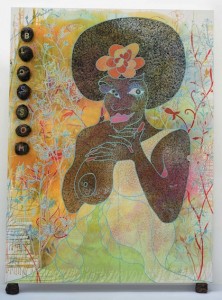
The nudes are flat and brown. Their eyes and mouths are left blank so that the paper comes through. This space is delicately decorated with colorful lines but they also transform these nudes into masks which in turn has a powerful affect on our own body as we seem to slide into the body of the nude herself. These works sum up the joyful provocation that Ofili has always been engaged in. Dung balls, black hairdos and brown odalisques are self referring but to what end? All we can do is laugh it off and the humorousness of the works enables this.
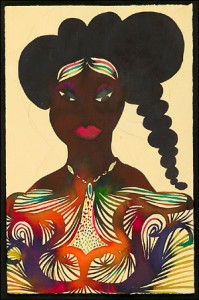
We then take up where we left off with the painting and enter a dark room with four tall dark blue paintings. It is hard to see in the weak moonlight of the pictures. We discern vegetal things in two, a hanging with a serenade in a third and a pair of horseman in the last one. This is a truncated series and it is a place where Offili could have spent more time letting the moon wax to reveal murderous ongoings in the jungle, for example. Instead we wander out of the semi darkness into a room too far.
Here Ofili has de-typified his entire opus. He has been pulled from the dark places to which he had retreated, or wandered, and is now in full moult in plain daylight. Sloppy monsters and elongated nudes in uncertain landscapes are represented in the most naive manner conceivable. The paint has been thinned and the glitter has blown away. The frailness of the figuration and composition is abetted by a choice of size and format that clearly overwhelm the artist.
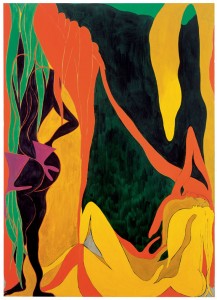
As works to show to the public they are of questionable value but as works that will enable the artist to evolve they are invaluable. In an ode to reality TV we see the face of creation that is often kept out of sight. Ofili is cooking with a new recipe and new ingredients. Will a meal take form before everything boils away and all that is left is a black crust at the bottom of the pot?




